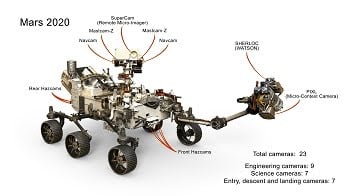Full company details
JENOPTIK Optical Systems LLC
Sub. of JENOPTIK AG
Advanced Photonic Solutions
 16490 Innovation Dr.
16490 Innovation Dr.
Jupiter, FL 33478
United States
Jenoptik Lenses to Provide First Images from Mars 2020 Rover Mission
Photonics Spectra
Oct 2019Jenoptik’s flight lenses designed for the Mars Rover 2020 mission have been delivered to NASA and will provide the first images that will be sent back to earth in February 2021.
The Jenoptik Light & Optics division team in Jupiter, Fla., has been developing three types of mission critical lenses for use with the Mars Rover’s engineering cameras.
Navigational lenses will capture the first live video footage from the mission as the rover autonomously explores the surface of Mars.

A selection of the 23 cameras on NASA's 2020 Mars rover. Many are improved versions of the cameras on the Curiosity rover, with a few new additions. Courtesy of NASA/JPL-Caltech.
Hazard avoidance lenses will provide images that will help the rover identify obstacles and allow NASA engineers to see the movement of the robotic arm during sample collection.
A cache lens will verify that a complete collection of the rock and soil samples has been achieved. Because of the cache lens’ proximity to the samples collected and the need to avoid contamination, the cleanliness requirements will be extremely challenging, Jenoptik officials said.
All three lens types were built in a Class 5 cleanroom with state-of-the-art filtration technology for high-precision optical assemblies. Custom test equipment was developed at Jenoptik to measure the optical performance needed to withstand the demanding temperature extremes and conditions on Mars. The company performed several environmental tests in vacuum and over a wide temperature range, with the lowest temperature being –135 °C.